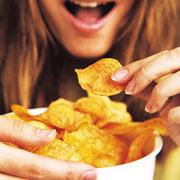 Making and breaking unnecessary proteins can burn up those extra calories.Getty
Making and breaking unnecessary proteins can burn up those extra calories.GettyEating as much as you like but never getting fat sounds like a dieter's dream. But it's a reality for mice missing a key gene, researchers have found.
These mice set up a futile cycle of making and breaking unnecessary proteins, burning fat along the way. As a result they eat more food but weigh less than normal mice. The discovery has raised hopes of novel ways to tackle obesity and diabetes.
The missing gene in this case codes for an enzyme needed to chemically digest some amino acids — the building blocks of proteins. This results in the build-up of an amino acid called leucine, which in turn tricks cells into making new, unnecessary proteins and then destroying them. This pointless cycle burns up excess calories so the mice stay trim, regardless of the extra food they munch.
Obesity results from an imbalance in the simple equation of energy input versus energy output, because excess fuel is turned into fat.
The notion that making and breaking down biological molecules can waste spare calories is not new to scientists; it has been posited as an explanation for why some lucky people can naturally eat more but stay slim. But this study, published in Cell Metabolism1 today, is the first time wasteful protein turnover has been shown in practice.
Munchies
Previous research has hinted that high-protein diets, or leucine supplements, cause weight loss — although the mechanism for how this happens is not well understood.
To find out what happens when leucine is permanently increased, Christopher Lynch of the Pennsylvania State University College of Medicine in Hershey and his colleagues inactivated a gene that normally clears this amino acid from the blood.
Lynch says the genetically modified mice "seemed more hungry than the other mice" and ate more, relative to their body weight. But even when they were put on a high-fat diet, which makes normal mice obese, these super-slim rodents stayed lean, carrying about half the body fat of their cage-mates. Their body temperature was increased slightly as all the extra food they craved was burnt off.
On a normal diet, the modified mice seemed healthy, weighed about 10% less than normal mice, and had a lower risk of developing diabetes.
But Lynch says the animals "went crazy" when the researchers altered their diet to lower the amount of leucine they could eat. "They were sitting next to their food, panting and eating," he says. The animals on this reduced-leucine diet were wet from sweat as they ate more and more, but still didn't gain weight. He speculates that the animals might be using the amount of leucine in their systems to determine how much they 'ought' to eat to reach their optimum weight.
Pill popping
Lynch is hopeful that harnessing wasteful protein-making in humans could be a novel way to treat obesity.
ADVERTISEMENT
Susan Fried, a researcher in endocrinology and nutrition at the University of Maryland in Baltimore, says the new research counters the idea that simply popping leucine supplements can result in long-term weight loss. Instead, it seems the key to shedding calories is in stopping leucine metabolism, rather than upping the intake of this amino acid.
This could conceivably be done in humans not by turning off a gene, but by designing a drug to block the enzyme that breaks down leucine. In theory, people on such a drug could eat a normal diet and still shed pounds, although what the side effects might be is unknown. Fried, who co-authors a piece in Cell Metabolism describing the new work2, says that any such therapy is "a long way down the road". It is good to be cautious, she says, when tinkering with something as fundamental as protein synthesis.
In the meantime, dieters will have to burn those excess calories down at the gym.
Visit our proteincyclekeepsmic.html">newsblog to read and post comments about this story.
